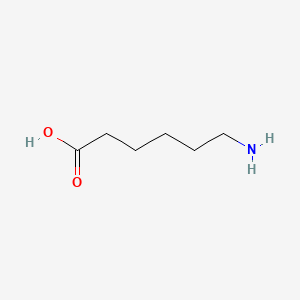| MeSH term | MeSH ID | Detail |
|---|---|---|
| Inflammation | D007249 | 119 associated lipids |
| Colonic Neoplasms | D003110 | 161 associated lipids |
| Diabetes Mellitus, Type 1 | D003922 | 56 associated lipids |
| Diabetes Mellitus, Experimental | D003921 | 85 associated lipids |
| Body Weight | D001835 | 333 associated lipids |
| Edema | D004487 | 152 associated lipids |
| Esophageal Neoplasms | D004938 | 20 associated lipids |
| Arthritis | D001168 | 41 associated lipids |
| Bone Neoplasms | D001859 | 5 associated lipids |
| Amyloidosis | D000686 | 4 associated lipids |
6-aminohexanoic acid
6-aminohexanoic acid is a lipid of Fatty Acyls (FA) class. 6-aminohexanoic acid is associated with abnormalities such as Blood Clot, Myocardial Infarction, Cerebrovascular accident, Renal impairment and Scoliosis, unspecified. The involved functions are known as Fibrinolysis, Agent, Hemorrhage, plasminogen activation and inhibitors. 6-aminohexanoic acid often locates in Chest, Blood, Body tissue, peritoneal and Plasma membrane. The associated genes with 6-aminohexanoic acid are P4HTM gene, BSND gene, MTPN gene, NDUFS4 gene and Homologous Gene. The related lipids are Phosphatidylserines and Butyric Acid.
Cross Reference
Introduction
To understand associated biological information of 6-aminohexanoic acid, we collected biological information of abnormalities, associated pathways, cellular/molecular locations, biological functions, related genes/proteins, lipids and common seen animal/experimental models with organized paragraphs from literatures.
What diseases are associated with 6-aminohexanoic acid?
6-aminohexanoic acid is suspected in Cerebrovascular accident, Blood Clot, Myocardial Infarction, Renal impairment, Thromboembolism, Postoperative myocardial infarction and other diseases in descending order of the highest number of associated sentences.
Related references are mostly published in these journals:
| Disease | Cross reference | Weighted score | Related literature |
|---|
Possible diseases from mapped MeSH terms on references
We collected disease MeSH terms mapped to the references associated with 6-aminohexanoic acid
PubChem Associated disorders and diseases
What pathways are associated with 6-aminohexanoic acid
There are no associated biomedical information in the current reference collection.
PubChem Biomolecular Interactions and Pathways
Link to PubChem Biomolecular Interactions and PathwaysWhat cellular locations are associated with 6-aminohexanoic acid?
Visualization in cellular structure
Associated locations are in red color. Not associated locations are in black.
Related references are published most in these journals:
| Location | Cross reference | Weighted score | Related literatures |
|---|
What functions are associated with 6-aminohexanoic acid?
Related references are published most in these journals:
| Function | Cross reference | Weighted score | Related literatures |
|---|
What lipids are associated with 6-aminohexanoic acid?
Related references are published most in these journals:
| Lipid concept | Cross reference | Weighted score | Related literatures |
|---|
What genes are associated with 6-aminohexanoic acid?
Related references are published most in these journals:
| Gene | Cross reference | Weighted score | Related literatures |
|---|
What common seen animal models are associated with 6-aminohexanoic acid?
There are no associated biomedical information in the current reference collection.
NCBI Entrez Crosslinks
All references with 6-aminohexanoic acid
Download all related citations| Authors | Title | Published | Journal | PubMed Link |
|---|---|---|---|---|
| Stricker PA et al. | Population pharmacokinetics of ϵ-aminocaproic acid in adolescents undergoing posterior spinal fusion surgery. | 2015 | Br J Anaesth | pmid:25586726 |
| Bitkova EE et al. | [Prophylaxis of blood loss and allogenic blood transfusion with fibrinolysis inhibitors produced in Russian Federation in patients undergoing cardiac surgery]. | 2014 Mar-Apr | Anesteziol Reanimatol | pmid:25055497 |
| Scepansky E et al. | Acquired von Willebrand syndrome with a type 2B phenotype: diagnostic and therapeutic dilemmas. | 2014 | Acta Haematol. | pmid:24296552 |
| Kong HY et al. | Epsilon-aminocaproic acid improves postrecirculation hemodynamics by reducing intraliver activated protein C consumption in orthotopic liver transplantation. | 2014 | World J Surg | pmid:24142329 |
| Verma K et al. | The relative efficacy of antifibrinolytics in adolescent idiopathic scoliosis: a prospective randomized trial. | 2014 | J Bone Joint Surg Am | pmid:24875032 |
| Sukegawa T | [A case of allergic contact dermatitis due to unit dose type purified sodium hyaluronate ophthalmic solution]. | 2014 | Nippon Ganka Gakkai Zasshi | pmid:24640792 |
| Leroux P et al. | Age-dependent neonatal intracerebral hemorrhage in plasminogen activator inhibitor 1 knockout mice. | 2014 | J. Neuropathol. Exp. Neurol. | pmid:24709679 |
| Anikin IV et al. | [Effect of epsilon-aminocaproic acid, cyclophosphamide and their combination on the growth of autochthonous sarcomas of mice induced by benzo(a)pyrene]. | 2014 | Vopr Onkol | pmid:24772624 |
| Lu Z et al. | Aprotinin, but not ε-aminocaproic acid and tranexamic acid, exerts neuroprotection against excitotoxic injury in an in vitro neuronal cell culture model. | 2014 | J. Thorac. Cardiovasc. Surg. | pmid:24237885 |
| Cheng L et al. | Discovery of the Fibrinolysis Inhibitor AZD6564, Acting via Interference of a Protein-Protein Interaction. | 2014 | ACS Med Chem Lett | pmid:24900876 |
